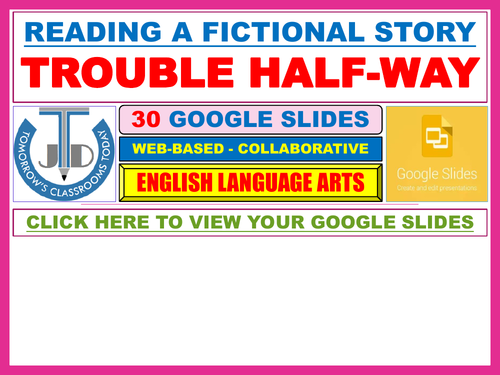





Interactive, collaborative and web-based google slides on reading comprehension of an extract from ‘Trouble Half-Way’ by Jan Mark based on New Bloom’s Taxonomy.
After completing this unit students will be able to:
- Find meaning of certain expressions - words and phrases - in the story.
- Answer questions to demonstrate knowledge of the setting of the story.
- Use the guide to identify character traits and make a character sketch of the main characters in the story.
- Use Freytag’s Pyramid to identify the elements and develop the plot of the story.
- Use analysis guide to identify the elements and make the critical appreciation of the story.
- Make a diary entry from the point of view of a main character in the story.
Here are some possible uses for these in your classroom:
- To challenge early finishers
- For effective tutoring
- As ESL stations and sub tubs
- As holiday work and homework
- For small group collaborations
- For an end of unit assessments
- For reinforcement and enrichment
Get this resource as part of a bundle and save up to 50%
A bundle is a package of resources grouped together to teach a particular topic, or a series of lessons, in one place.
READING SHORT STORIES - BLOOM'S TAXONOMY-BASED GOOGLE SLIDES - BUNDLE
This bundle of 6 products (Google Slides) is perfect for teaching Reading Comprehension of Short Stories. These no prep activities would be great for ELA lessons. Your students will love these tasks that are planned for student engagement. After completing these tasks, your students will be able to: * Give or explain the meaning of words in context. * Identify/explain how meaning is enhanced through choice of words and phrases. * Identify key details from fiction. * Retrieve and record information from fiction. * Summarise main ideas from the text. * Make inferences from the text. * Make comparisons within the text. * Predict what might happen from details stated and implied. * Identify/explain how information or narrative content is related and contributes to meaning as a whole. * Explain and justify inferences with evidence from the text. This bundle includes Google Slides on: * The Model Millionaire: 29 Slides * My Lost Dollar: 22 Slides * The Scarecrow and His Servant: 23 Slides * Trouble Half-Way: 44 Slides * The Discontented Fish: 25 Slides * The World's Greatest Dad: 19 Slides ◈◈◈◈◈◈◈◈◈◈◈◈◈◈◈◈◈◈◈ Save 30% on this BUNDLE! Note: These are also sold separately! ◈◈◈◈◈◈◈◈◈◈◈◈◈◈◈◈◈◈◈
READING FICTION: BLOOM'S TAXONOMY BASED - BUNDLE
A bundle of 4 products on prose comprehension of the fictional story, "Trouble Half-Way" (an extract) by Jan Mark based on New Bloom's Taxonomy. After completing this unit students will be able to: * Find meaning of certain expressions - words and phrases - in the story. * Answer questions to demonstrate knowledge of the setting of the story. * Use the guide to identify character traits and make a character sketch of the main characters in the story. * Use Freytag’s Pyramid to identify the elements and develop the plot of the story. * Use analysis guide to identify the elements and make the critical appreciation of the story. * Make a diary entry from the point of view of a main character in the story. This download includes: * Worksheets with Answers: 20 Exercises * Unit Lesson Plan: 6 Sessions * PowerPoint Presentation: 30 Slides * Google Slides: 44 Slides Here are some possible uses for these in your classroom: * To challenge early finishers * For effective tutoring * As ESL stations and sub tubs * As holiday work and homework * For small group collaborations * For an end of unit assessments * For reinforcement and enrichment ◈◈◈◈◈◈◈◈◈◈◈◈◈◈◈◈◈◈◈◈◈◈◈◈◈◈◈ Save 50% on this BUNDLE! Note: These are also sold separately! ◈◈◈◈◈◈◈◈◈◈◈◈◈◈◈◈◈◈◈◈◈◈◈◈◈◈◈
Something went wrong, please try again later.
This resource hasn't been reviewed yet
To ensure quality for our reviews, only customers who have purchased this resource can review it
Report this resourceto let us know if it violates our terms and conditions.
Our customer service team will review your report and will be in touch.